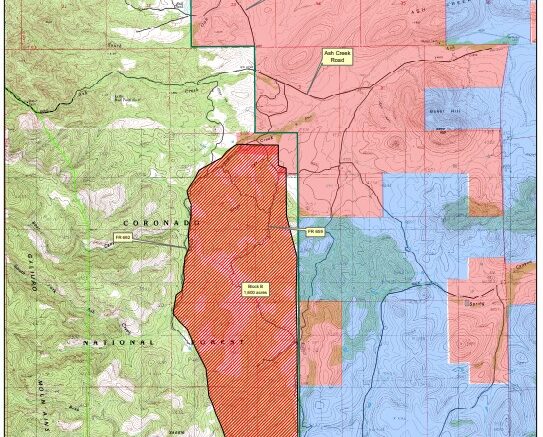Contributed article
SAFFORD — Starting May 30, and running through June 9, the Safford Ranger District, Coronado National Forest, plans to complete the work of a prescribed broadcast burn operation that was pretreated earlier this year.
Broadcast burning is a form of prescribed burning activity where fire is applied generally to most or all of an area within well-defined boundaries for reduction of fuel hazard, as a resource management treatment, or both.
March 2023, pretreatment consisted of blacklining the perimeter. Blacklining is a technique of burning a perimeter around the planned burn area while at lower fire behavior conditions to aid in holding operations when optimal burning conditions become available later in the season. This year, fuel moisture levels have been unusually high due to the above-normal winter precipitation. Conditions are now met to optimally fulfill the objects of the prescribed broadcast burn.
The Rockhouse 2 project area consists of National Forest System lands in the southeast portion of the Galiuro Mountains in southeastern Arizona, and is included in the Coronado’s Galiuro FireScape Project. The project boundaries lie between Redfield Canyon on the west, the Forest Boundary on the east and south end, and Bassett Peak on the north end.
We expect to treat approximately 1,600 acres in block B on the SE portion of the Galiuro Mountains depending on weather conditions. Burning is expected for 1-2 days, with ignitions occurring as fuel and weather conditions become suitable. Crews will secure and monitor the burn for several days post ignitions.
Smoke will be visible from Sulphur Springs Valley and Bonita, Willcox, Benson, San Manuel, Oracle, Klondyke, and the surrounding areas for the duration of the project. No closure orders will be in place, but the public within the area should use caution or recreate in other areas.
Fire has played an important ecological role in the history of the grassland and woodland ecosystems of southeastern Arizona. Regular intervals of naturally occurring fire restricted the growth of shrubs in grasslands, thinned forests of fire-intolerant trees, increased stream flows, and renewed wildlife habitat.
A decrease in the frequency of natural fire has resulted in areas of dense, overgrown vegetation and the accumulation of fuel available for wildfires. The project is designed to meet the objectives of the Wildfire Crisis Strategy by reducing the accumulation of hazardous fuels, improving range and watershed conditions, improving wildlife habitat, returning the ecosystem to a more fire-resilient state, and reducing the likelihood of future high-intensity wildfires within the project area.
By reducing the probability of extreme fire behavior in future wildland fires, the intent is to subsequently reduce threats to firefighters, increase public safety, as well as reduce costs and resource damage due to fires.
For any additional questions feel free to contact the Coronado National Forest at Mailroom_R3_Coronado@usda.gov. For the most current updates about the Coronado National Forest, please follow us on Facebook at https://www.facebook.com/CoronadoNF and Twitter at https://twitter.com/CoronadoNF









.jpg)